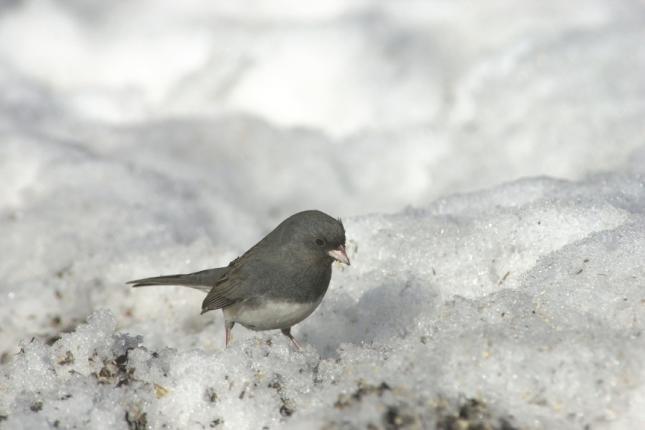October Bird of The Month - Dark-eyed Junco

Fun Facts About Juncos
- The Dark-eyed Junco is currently divided into six distinct populations that include the following: Oregon, Pink-sided, White-winged, Slate-colored, Gray-headed, and Red-backed Juncos.
- There are an additional 12 subspecies divided among these populations.
- The Dark-eyed Junco has been documented to produce hybrids with White-throated Sparrows.
- Dark-eyed Juncos are often called “Snowbirds,” possibly due to the fact that many people believe their return from their northern breeding grounds foretells the return of cold and snowy weather. Another possible source of the nickname may be the white belly plumage and slate-colored back of the junco which has been described as “leaden skies above, snow below.”
- Juncos spend the entire winter in flocks averaging in size from six to thirty or more birds.
- Dark-eyed Juncos tend to return to the same area each winter. Chances are that you have many of the same birds at your feeder this winter that you had in previous years.
- Visiting flocks of juncos will usually stay within an area of about ten acres during their entire winter stay.
- To avoid the competition, many female juncos migrate earlier and go farther south than most of the males. In Michigan only 20% of the wintering juncos are females, whereas in Alabama 72% were found to be female.
- Male juncos tend to spend the winter farther north in order to shorten their spring migration and thus gain the advantage of arriving first at prime breeding territories.
- Juncos migrate at night at very low altitudes and are susceptible to collisions with communication towers and other structures.
- Each winter flock of juncos has a dominance hierarchy with adult males at the top, then juvenile males, adult females and young females at the bottom. You can often observe individuals challenging the status of others with aggressive displays of lunges and tail flicking.
- While the southward migration of Slate-colored Juncos is complete by early December, there is some evidence that indicates that harsh winter weather may spur some juncos to move further south at anytime during the winter.
- Juncos have over 30% more feathers (by weight) in the winter than they do in summer.
- Juncos prefer to roost in evergreens at night but will also use tall grasses and brush piles. They return to the same roost location repeatedly and will share it with other flock mates, but they do not huddle together.
- Partners in Flight currently estimates the North American population of Dark-eyed Juncos at approximately 260 million, second only to the American Robin in overall population size in North America. A separate research paper estimates that the junco population could actually be as high as 630 million.
- According to Project Feeder Watch, juncos are sighted at more feeding areas across North America than any other bird. Over 80% of those responding report juncos at their feeders.
- Juncos are known to burrow through snow in search of seeds that have been covered over.
- On an annual basis, a junco’s diet is made up of approximately three parts seeds to one part insects.During the nesting period, the percent of insects can increase up to 50-60% of their diet.
- You may not like these weeds in your yard, but the seeds of chickweed, ragweed, knotweed, pigweed, lamb’s quarters and crabgrass are some of the main natural seed sources used by juncos.
- You can attract juncos to your yard by feeding a seed blend containing millet and hulled sunflower seeds.
- Male juncos return and reclaim the same breeding territory year after year.
- Juncos typically have two broods per year with the female building her nest on or near the ground and laying three to five eggs. The male does not incubate the eggs but does deliver food to the young and helps the female to defend against predators. The young leave the nest in 9-12 days.
- Studies have shown that Dark-eyed Junco’s nests are the victim of predators between 20-80% of the time.
- The longevity records for juncos are:
- White-winged – 7 ½ years
- Slate-colored - 11 years, 4 months
- Oregon - 9 years, 9 months
- Gray-headed - 10 years, 8 months

